The Micromanager's Paradise
Sirian apparently set up this whole start to illustrate the need for micromanagement. First, we demonstrate the need to move your worker before founding the city. Doing so reveals a wheat, and if the settler moves east, we can irrigate "through the city square" to irrigate the wheat right away. Next turn, moving the worker onto the wheat reveals two shield grasslands. If those hadn't been there, however, I would move ANOTHER square upriver, still adjacent to the wheat, seeking one. Research to max on Pottery of course.
Tenochtitlan gets 3-3-3-3-4-4 food and grows with no waste. Computer assigns second citizen to the forest, but I keep it on the river grassland. I'll trade one turn of Jaguar Warrior for two food. When Tenoch expands, it gets a shield grassland. Grows again in 5 turns; need lux tax, Tenoch still on +4 food surplus. First jag goes north through jungle. Second jag goes as far as the mountain to the south to get a view, and then returns for police duty. At size 4, I once again reassign Tenoch to max food.
Pottery at end of 3100BC; Writing next. I did not research Writing at minimum science, but I should have - it took 37 turns. I could have saved a couple hundred gold to use for deficit research later.
At size 5, I let Tenoch work the forest so that the granary will complete before it grows again. When the granary is 7 shields from completion, I move it back to max food: granary in 2 turns, growth in 3. Granary completes, settler next.
From now until AD times, I micromanage Tenochtitlan every single turn. It can grow every 3 turns by getting 3-3-4 surplus food. I put the 4 on the last turn of each cycle so that it will be set to working max food at the moment of growth, ensuring that it auto-picks a forest on the turn of growth, for those extra shields. It cranked somewhere around fifteen settlers in this way.
In 2430 BC, our second city, Teotihuacan, is founded, and immediately begins The Pyramids (via Colossus placeholder.) Hmm.. looks like I'll have to mine the wheat next to it; can't get irrigation there just yet (since I mined the two grasslands between it and Tenoch's wheat.)
2270: Tlatelolco founded W of the flood plains wheat ( flood plains? Lakes don't generate flood plains...), and starts a worker. In fact, it begins churning workers like mad. In fact, it can grow faster than it can produce workers! This city would produce nothing but workers (besides a library) in steady-state every three turns once it got a granary, until the Industrial Age.
flood plains? Lakes don't generate flood plains...), and starts a worker. In fact, it begins churning workers like mad. In fact, it can grow faster than it can produce workers! This city would produce nothing but workers (besides a library) in steady-state every three turns once it got a granary, until the Industrial Age.
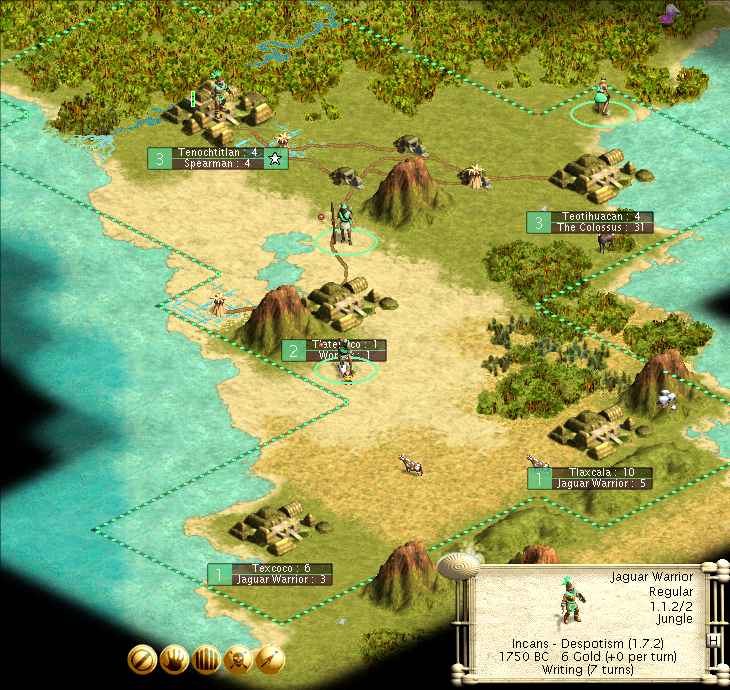
1600 BC: Writing discovered. What next? We want Literature... but we'll finish the Colossus placeholder before we get it. If Lit would come first, we could use GL as a placeholder. And a Palace placeholder requires - of all things - Masonry. We have to take Masonry now, and it comes in 1350 BC, when we start Literature, which comes in 975 BC. What next? Map Making.
1300 BC: Three settlers complete on the same turn, at Tenochtitlan, Tlatelolco, and Texcoco. I start several cities on Barracks placeholders for their Libraries. In 1150, Dyes and Gems get hooked up, and we kill the lux tax.
Whack.  Whack. That's the sound of libraries being whipped. Whack. Learn, you fools! Whack. With Pyramids in hand, whipping is spectacularly efficient - turning 10 food into 20 corruption-free shields. That's like doubling even the lowliest city's land production! Tlaxcala, having built its library without whipping, starts the Colossus for real.
Whack. That's the sound of libraries being whipped. Whack. Learn, you fools! Whack. With Pyramids in hand, whipping is spectacularly efficient - turning 10 food into 20 corruption-free shields. That's like doubling even the lowliest city's land production! Tlaxcala, having built its library without whipping, starts the Colossus for real.
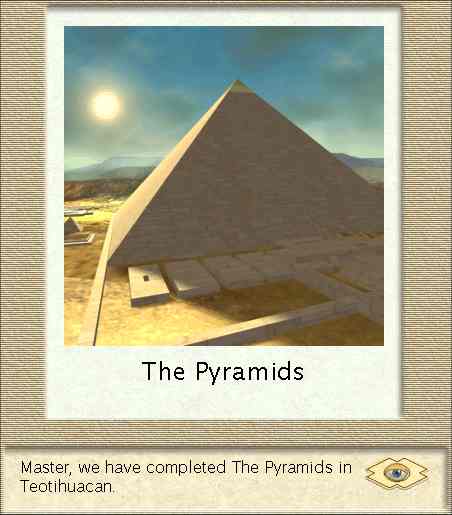
750: The Pyramids complete in Teotihuacan! Excellent. It now begins the Great Lighthouse. It's clear by now that we're alone on our continent, which I should have known from the theme and the fact that the map was customized. I've produced very little military - a dozen jaguars from cities that needed them for police, and that's it.
730: Map Making discovered. What next? Straight to Republic, or sidetrack to Ceremonial Burial to get Temples going? I decide to take the sidetrack; it'll come in the minimum 4 turns with +18 gold/turn, and that +18 will let us run a deficit later and speed Republic. Ceremonial Burial comes in 650 BC. Code of Laws comes 8 turns after that, Philosophy in 4, and Republic is due in 14 turns, at 90% science / -11gpt.
France builds the Oracle, almost certainly a cascade from the Pyramids.
A galley sees land four squares to the west of Texcoco! Can it survive one turn at sea? Yes! Will there be other civs here? Don't know. If not, it'll be great land for us to settle. Another galley going east from Xochicalco does the same... and also survives! Turns out there's nobody on these lands - more space for us. After some exploring, we discover that there's one safe lane open to the island, even without the Lighthouse. I start sending settlers over.
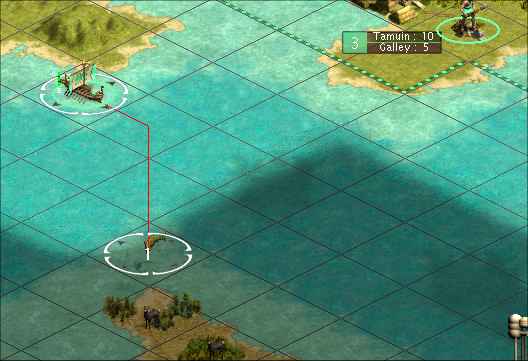
The French complete Colossus, when Tlaxcala was 5 turns away. Oh well. Swap to Great Library. If the other civs are in contact with each other, that'll help greatly when we find them.
By 390 BC, most of our cities have been founded, all with the benefits of the Pyramids. I check on the culture total... 896. Almost one percent of the way there. 
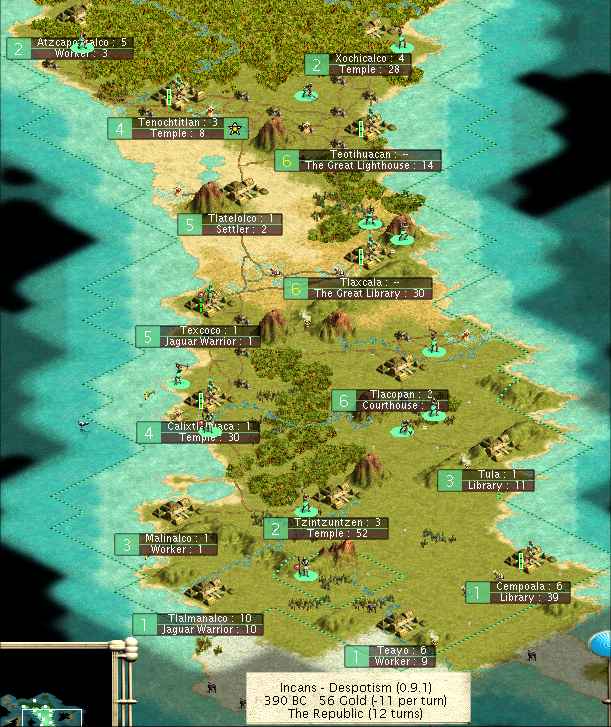
I sent most of the settlers south towards more fertile lands, but sent about every third settler north into the jungle. Any square in the jungle that had access to ANY sort of two-food square -- grasslands around the fringes, fish, that one lake square -- got settled. By doing so, that city can build a worker just as it grows to size two, dropping it back to size one, which is fine since there's no good square to work at size two. Then it can do that again, and the second worker can join the first in jungle-clearing. Now the city has two grassland squares to work at size two, and can produce a worker in five turns (with the Pyramids). Now three workers, and then four, can clear jungle just about as fast as the city can grow - and if the city ever outpaces its improved squares, *WHACK* out a library. In this way, each of the cities can slowly bootstrap itself out of the jungle, and turn into population and science powerhouses. You can see this in action here. Compare this picture with the 10 AD picture on the next page.
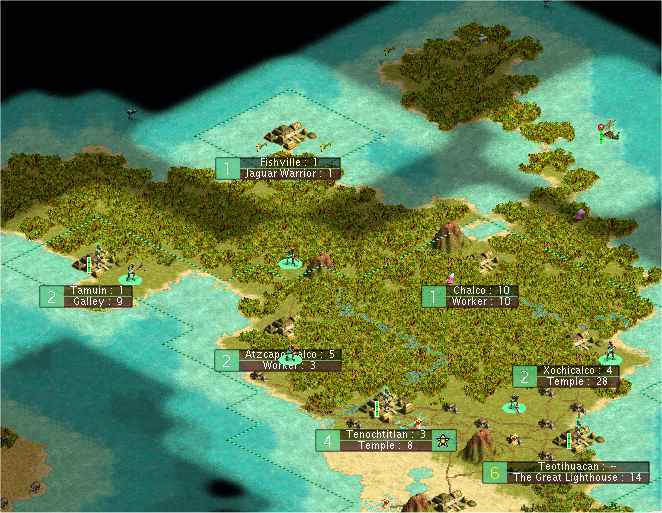
I might have gotten a bit overeager in doing that, though; probably should have dotmapped the whole thing first. I wound up with about six tiles unused - a bad thing if you're going for max population. One other thing - I had workers chopping down all of the game forests in the southern lands. In despotism, a forest-game is equal to a mined shielded grassland. After chopping, it's identical to a grassland wheat, which in despotism is far better (especially considering whipping.)
Continue...
Home |
Page One |
Page Two |
Page Three |
Page Four
 flood plains? Lakes don't generate flood plains...), and starts a worker. In fact, it begins churning workers like mad. In fact, it can grow faster than it can produce workers! This city would produce nothing but workers (besides a library) in steady-state every three turns once it got a granary, until the Industrial Age.
flood plains? Lakes don't generate flood plains...), and starts a worker. In fact, it begins churning workers like mad. In fact, it can grow faster than it can produce workers! This city would produce nothing but workers (besides a library) in steady-state every three turns once it got a granary, until the Industrial Age. Whack. That's the sound of libraries being whipped. Whack. Learn, you fools! Whack. With Pyramids in hand, whipping is spectacularly efficient - turning 10 food into 20 corruption-free shields. That's like doubling even the lowliest city's land production! Tlaxcala, having built its library without whipping, starts the Colossus for real.
Whack. That's the sound of libraries being whipped. Whack. Learn, you fools! Whack. With Pyramids in hand, whipping is spectacularly efficient - turning 10 food into 20 corruption-free shields. That's like doubling even the lowliest city's land production! Tlaxcala, having built its library without whipping, starts the Colossus for real.